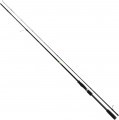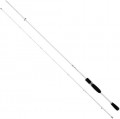Tip type
The type of tip provided in the design of the rod.
This parameter is relevant mainly for spinning rods (see "Rod type"). The tip is the very tip of the rod; the characteristics of this part largely determine the features of the use of spinning. Nowadays, two main types of tips are used —
Solid Tip (pasted) and
Tubular Tip (hollow), here are their main features:
— Pasted (Solid Tip). A tip glued into the rod that does not have cavities and is usually made of fibreglass or a special type of carbon fibre. Such tips are very flexible and are mainly used for jig and microjig — fishing using special lures and sinkers, as well as a special (actually "jig") wiring technique. One of the key advantages of Solid Tip in this application is a clear “shooting” (jump) of the tip when lowering the bait to the bottom; this moment is important for the control of jig gear.
— Hollow (Tubular Tip). Traditional hollow (tubular) tip. Such a tip is noticeably stiffer than the Solid Tip, and is intended mainly for twitching fishing — wiring lures, wobblers and other similar nozzles. With this type of fishing, you often have to pull the bait hard or move it in jerks, and due to the high rigidity of the Tubular Tip, it is optimally suited for this fishing technique: a rod with such a tip does not bend as much as with a Solid Tip, and allows you to precisely control the lure.
— Hybrid (Hybrid tip)
.... The lower part of the hybrid tip is hollow to about the middle (Tubular), and above it is solid (Solid). She is moderately rigid, and bending in one sitting. It is used as a universal solution for various fishing techniques.
Note that individual models of rods can be equipped with two types of tips at once, with the possibility of installing them at the request of the user. However, such equipment is rare: spinningists usually select tackle for specific conditions and fishing style.Max. casting
The maximum weight of the entire rig (including bait, weights, hooks, etc.) that the rod can handle. This parameter is not recommended to be exceeded: the structure will be subjected to off-design loads and wear out a lot, to the point that the rod can simply break during a normal cast. In addition, the off-design weight of the casting significantly reduces the range and accuracy of the cast, which is critical, in particular, in spinning and match fishing (see "Rod type").
Min. casting
The minimum weight of equipment (lures, sinkers, hooks, floats, etc.) with which the rod will work effectively. Compliance with this parameter is important, first of all, for types of fishing that require high accuracy, for example, match or spinning (for more details, see "Rod Type") — a rig that is too light will not allow you to cast the rod far enough and accurately.
Working length
The length of the rod in the unfolded (working) position. For different types of fishing, different lengths are considered optimal; see "Rod Type" for more on this. If the type of rod you need has numerous length variations, when choosing, you should take into account the conditions in which you have to fish. On the one hand, longer models usually have a greater casting distance (this is especially true for float fishing); on the other hand, for limited conditions (for example, with dense vegetation on the shore or when fishing from a boat), it may make sense to take a shorter rod.
Folded length
The length of the rod when folded. This parameter primarily affects the convenience of transportation: the shorter the folded rod, the easier it is to carry / transport.

